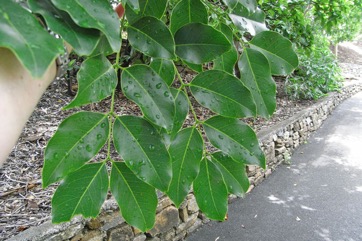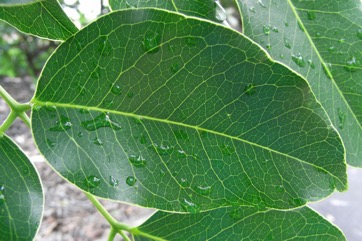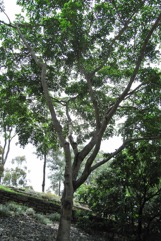African mahogany, Lucky-bean tree

It grows in the tropics. It grows in wooded grassland and better rainfall areas. It can grow in dry stony soils. It grows between 1,220-1,370 m above sea level. It can grow in arid places.
Also known as:
Akpalata, Aru, Becancha, Becancla, Bignani, Biique, Butaua, Butone, Congo, Gbeou, Gongo, Kankalga, Lencom-o, Lengue, Lenguei, Lengueje, Leonco, Lingue, Luengue, Meli, Oru, Papao, Pau-conta, Pega, Po-de-conta, Yiase
Synonyms
- Intsia ?, Pahudia africana,
Edible Portion
- Seeds, Leaves, Fruit - aril, Vegetable
Where does African mahogany grow?
Found in: Africa, Benin, Burkina Faso, Cameroon, Central Africa, Central African Republic, CAR, Congo, Côte d'Ivoire, East Africa, Ghana, Guinea, Guinée, Guinea-Bissau, Ivory Coast, Liberia, Niger, Nigeria, Senegal, Sierra Leone, S Sudan, Sudan, Togo, Uganda, West Africa
Notes: There are 15 Afzelia species. They occur in the tropics. Also as Caesalpinaceae.
Status: They are chewed especially by children.
Growing African mahogany, Lucky-bean tree
Cultivation: Plants are grown from seed. Seed can be self sown, sown where they are to grow or can be put in a nursery. The orange aril should be removed from the seed and cutting the seed coat slightly may help seed germinate. Seed can be stored for a long time in an airtight container. Plants can be budded.
Edible Uses: The aril of the seed is eaten. The seeds are used as a soup thickener. The seeds are also used as a spice. The young leaves and young fruit are eaten. The seeds are made into flour for biscuits.
Production: The plant is slow growing.
Nutrition Info
per 100g edible portion| Edible Part | Energy (kcal) | Protein (g) | Iron (mg) | Vitamin A (ug) | Vitamin c (mg) | Zinc (mg) | % Water |
|---|---|---|---|---|---|---|---|
| Seeds | - | - | - | - | - | - | |
| Leaves | - | - | - | - | - | - |
African mahogany, Lucky-bean tree Photos



References
Abbiw, D.K., 1990, Useful Plants of Ghana. West African uses of wild and cultivated plants. Intermediate Technology Publications and the Royal Botanic Gardens, Kew. p 41
Alyegba, S. S. et al, 2013, Ethnobotanical Survey of Edible Wild Plants in Tiv Communities of Benue State, Nigeria. Journal of Natural Sciences Research. Vol.3, No.7
Belem, B., et al, 2007, Use of Non Wood Forest Products by local people bordering the “Parc National Kaboré Tambi”, Burkina Faso. The Journal of Transdisciplinary Environmental Studies vol. 6, no. 1 p 9
Belem, M., et al, 2017, Strategy of Conservation and Protection of Wild Edible Plants Diversity in Burkina Faso. ANADOLU 27 (2) 2017, 82- 90
Bircher, A. G. & Bircher, W. H., 2000, Encyclopedia of Fruit Trees and Edible Flowering Plants in Egypt and the Subtropics. AUC Press. p 12
Bonou, A., et al, 2013, Valeur economique des Produits Forestiers Non Ligneux (PFNL) au Benin. Editions Universitaires Europeennes p 90
Burkill, H. M., 1985, The useful plants of west tropical Africa, Vol. 3. Kew.
Chapman, J. D. & Chapman, H. M., 2001, The Forest Flora of Taraba and Andamawa States, Nigeria. WWF & University of Canterbury. p 181
Codjia, J. T. C., et al, 2003, Diversity and local valorisation of vegetal edible products in Benin. Cahiers Agricultures 12:1-12
Dalziel, J. M., 1937, The Useful plants of west tropical Africa. Crown Agents for the Colonies London.
Dansi, A., et al, 2008, Traditional leafy vegetables and their use in the Benin Republic. Genet Resour Crop Evol (2008) 55:1239–1256
Dansi, A., et al, 2009, Traditional leafy vegetables in Benin: folk nomenclature, species under threat and domestication. Acta Bot. Gallica 156(2), 183-199
FAO Corporate Document Repository. The Major Significance of 'Minor' Forest Products. Appendix 3
Gallagher, D. E., 2010, Farming beyond the escarpment: Society, Environment, and Mobility in Precolonial Southeastern Burkina Faso. PhD University of Michigan.
Goode, P., 1989, Edible Plants of Uganda. FAO p 41
Grivetti, L. E., 1980, Agricultural development: present and potential role of edible wild plants. Part 2: Sub-Saharan Africa, Report to the Department of State Agency for International Development. p 43
Grubben, G. J. H. and Denton, O. A. (eds), 2004, Plant Resources of Tropical Africa 2. Vegetables. PROTA, Wageningen, Netherlands. p 559
Guinko, S. & Pasgo, L. J., Harvesting and marketing of edible products from local woody species in Zitenga, Burkina Faso. Unasylva - No. 168
Hedrick, U.P., 1919, (Ed.), Sturtevant's edible plants of the world. p 28
Jardin, C., 1970, List of Foods Used In Africa, FAO Nutrition Information Document Series No 2. p 51
Katende, A.B., Birnie, A & Tengnas B., 1995, Useful Trees and Shrubs for Uganda. Identification, Propagation and Management for Agricultural and Pastoral Communities. Technical handbook No 10. Regional Soil Conservation Unit, Nairobi, Kenya. p 68
Kristensen, M and Lykke, A. M., 2003, Informant-Based Valuation of Use and Conservation Preferences of Savanna Trees in Burkina Faso. Economic Botany, Vol 57, No. 2, pp. 203-271
Martin, F.W. & Ruberte, R.M., 1979, Edible Leaves of the Tropics. Antillian College Press, Mayaguez, Puerto Rico. p 197
Menninger, E.A., 1977, Edible Nuts of the World. Horticultural Books. Florida p 89
Okigbo, B.N., Vegetables in Tropical Africa, in Opena, R.T. & Kyomo, M.L., 1990, Vegetable Research and development in SADCC countries. Asian Vegetable Research and development Centre. Taiwan. p 42
Peters, C. R., O'Brien, E. M., and Drummond, R.B., 1992, Edible Wild plants of Sub-saharan Africa. Kew. p 120
Royal Botanic Gardens, Kew (1999). Survey of Economic Plants for Arid and Semi-Arid Lands (SEPASAL) database. Published on the Internet; http://www.rbgkew.org.uk/ceb/sepasal/internet [Accessed 21st April 2011]
Salvi, J. et al, 2016, A review: Underutilized wild edible plants as a potential source of alternative nutrition. International Journal of Botany Studies. Volume 1; Issue 4; May 2016; Page No. 32-36
Syn. pl. 1:455. 1805
Vivien, J. & Faure, J.J., 1985, Abres des forets dense d'Afrique Centrale. Agence de Cooperation Culturelle et Technique. Paris. p 66
World Checklist of Useful Plant Species 2020. Royal Botanic Gardens, Kew
www.worldagroforestrycentre.org/sea/products/afdbases/af